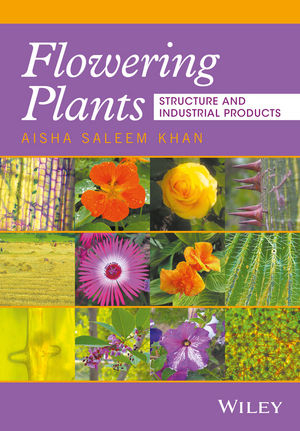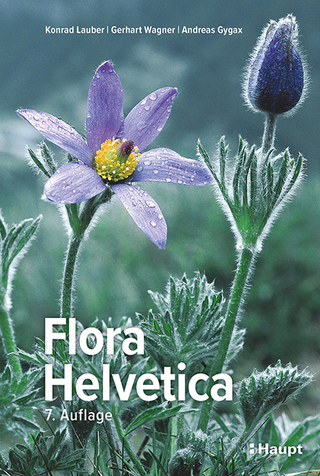
Flowering Plants
John Wiley & Sons Inc (Verlag)
978-1-119-26277-0 (ISBN)
This up-to-date reference provides a thorough understanding of plant structure and chemical and molecular processes found in angiosperms. It covers many important topics on applied botany, and therefore, can also be used as a textbook for students of related fields. It details the latest research in the field, along with areas in need of further study, for students, researchers, and professionals working in industry. The book takes advantage of technological innovations to showcase a range of advanced techniques for studying plant structure and metabolites, such as cryo-electron microscopy, ultramicroscopy, x-ray crystallography, spectroscopy, and chromatography. Filled with helpful illustrations, diagrams, and flowcharts to aid comprehension, Flowering Plants offers readers the morphological, anatomic, and molecular knowledge about angiosperms they need for a range of industrial applications.
Aisha Saleem Khan is Associate Professor in the Department of Biological Sciences at Forman Christian College, Pakistan. She received her Ph.D. from the University of Punjab and held a post-doctoral research post at Miami University, Ohio. Her research, which focuses on plant anatomy, electron microscopy, and heavy metal toxicity, has been published in national and international publications. Aisha has over 12 years’ of teaching experience in plant systematics and applied botany.
Preface xv
Acknowledgements xvii
1 An Introduction to Flowering Plants: Monocots and Eudicots 1
1.1 An Introduction to Major Group of Angiosperms: Monocots, Eudicots and Basal Angiosperms 1
1.2 Plant Cell: Revisions and Few Updates 5
1.3 Intracellular and Extracellular Communications are Crucial for Cells’ Metabolic Demands 19
1.4 Future Perspectives 22
References 23
Further Reading 23
2 An Introduction to Angiosperm Natural Products 31
2.1 Introduction 31
2.2 Glucose Serves as a Precursor for Formation of Primary and Secondary Metabolites in Plants 32
2.3 Classification of Natural Products of Angiosperms 33
2.4 Techniques for Isolation of Secondary Metabolites With Future Perspectives 44
References 46
Further Reading 47
3 Plant Tissues Organization of Angiosperms 53
3.1 Introduction to Plant Tissues 53
3.2 Diversity of Plant Cell 53
3.3 Parenchyma is the Main Ground Tissue of Plants 55
3.4 Collenchyma: Introduction and Distribution 55
3.5 Sclerenchyma is the Mechanical Tissue of Plants 57
3.6 Vascular Tissues: Xylem and Phloem 61
3.7 Phloem 69
3.8 Future Perspectives 72
References 72
Further Reading 73
4 Floral Cell Biology and Diversity in Floral Cells 77
4.1 Introduction to Angiosperms Flowers: Monocots and Eudicots 77
4.2 Morphological & Anatomical Characteristics of Eudicot Flowers 77
4.3 Morphology of Monocots Flowers 95
4.4 Channels and Transporters Within Floral Cells 98
4.5 Future Perspectives 102
References 102
Further Reading 103
5 Signaling During Sexual Reproduction in Angiosperms 107
5.1 Introduction 107
5.2 Angiosperms Show Diversity in Their Sporophytic and Gametophytic Generations 108
5.3 Angiosperms Spend Most Part of Their Lives as Sporophytes and Produce Gametophytes for a Shorter Period of Time 108
5.4 Septs From Pollination to Fertilization 111
5.5 Future Perspectives 128
References 128
Further Reading 129
6 Physiologically Active Metabolic Pathways in Floral Cells 135
6.1 Introduction to Floral Physiology 135
6.2 Glucose Fates in Floral Cells Differ According to Their Metabolic Demands 137
6.3 PPP Provides Floral Cells With Their Nucleotides and Important Pigments 141
6.4 ATP and NADPH Produced Through Photochemical Reactions Provide Energy for Sugar Formation in Stroma of Chloroplasts 143
6.5 Floral Photosynthesis Contributes to Sugar Requirements of Floral Whorls 145
6.6 Future Perspectives 155
References 155
Further Reading 156
7 Anthocyanins: Accumulation in Plants and Role in Industries 161
7.1 Anthocyanins Accumulation in Different Organs Is Indicative of Their Multiple Roles 161
7.2 Anthocyanidin Biosynthesis Takes Place in Cytosol of Cells, However, They are Accumulated in Vacuoles 162
7.3 Anthocyanins Exist in Modified Forms in Cells 165
7.4 Anthocyanins Transport to Vacuoles 168
7.5 Anthocyanins Role is Dependent Upon Their Location and Accumulation 168
7.6 Industrial Applications of Anthocyanins 178
7.7 Future Perspectives 181
References 182
Further Reading 184
8 Carotenoids: Introduction, Classification and Industrial Uses 189
8.1 Carotenoids are Vital for Leaves as Light Absorbing Pigments and for Flowers to Attract Their Pollinators 189
8.2 Oxygenated and De-oxygenated Carotenoids are Major Carotenoids in Angiosperms 190
8.3 Carotenoid Biosynthesis is Under the Control of Transcriptional Regulation 193
8.4 Carotenoids are Localized in Plastids in Form of Crystals and Plastoglobuli 193
8.5 Carotenoids Accumulation Takes Place in Chromoplasts of Autumn Leaves of Eudicots 197
8.6 Carotenoids Pigments in Flowers and Pollens 197
8.7 Lutein are Important Antenna and Photoprotective Pigments in Thylakoids of Chloroplasts 199
8.8 Capsaicin is a Carotenoid Derivative Which Causes Hotness of Capsicum spp. 200
8.9 Carotenoid Accumulation in Epidermal Cells of Many Fruits is Due to Conversion of Chloroplast Into Chromoplasts 202
8.10 Transcriptional Regulation of Carotenoids in Fruits 203
8.11 Application in Food, Pharmaceutical, Cosmetic, Textile and Nutracuetical Industries 203
8.12 Future Challenges 205
References 207
Further Reading 208
9 Alkaloids Biosynthesis, Translocation and Industrial Products 213
9.1 Alkaloids are Nitrogen-Containing Natural Products Which Provide Defense Against Herbivores 213
9.2 Alkaloids are Synthesized in Cytosol and Accumulated in Vacuoles as They are Toxic for Plant Cells 216
9.3 Purine Nucleotides Serve as Precursors of Caffeine Synthesis 219
9.4 History of Discovery of Caffeine 222
9.5 Theobromine is an Alkaloid Widely Used in Chocolates and Teas 227
9.6 Clinical Applications of Alkaloids are Due to Their Mode of Action 228
9.7 Development of Physiologically Functional Food Containing Alkaloids as Food Vaccines 230
References 236
Further Reading 237
10 Nectaries, Carnations and Ornamental Hybrid Flowers in Floriculture 241
10.1 Introduction 241
10.2 Nectaries are Nectar Synthesizing Structures of Plants 242
10.3 Ornamental Transgenic Plants in Floriculture 247
10.4 Dianthus spp. are Major Carnations in Floriculture 250
10.5 Future Perspectives in Floriculture Industries 255
References 255
Further Reading 256
11 Floral Essential Oils: Biosynthesis, Classification and Commercial Applications 261
11.1 Fragrance Formation is a Unique and Genetically Controlled Characteristic of Many Angiosperms 261
11.2 Number of Carbon and Hydrogens Atoms in Isoprene Units Determine Their Roles in Plants 263
11.3 Many Terpenoids are Insecticidal and Act as Allelochemicals 272
11.4 Sesquiterpenes are Defensive Terpenoids of Many Plants 272
11.5 Diterpenoids are Important Phytohormones Which Comprise of Four Isoprenoid Inits 274
11.6 Terpenoid Biosynthesis in Plants Proceeds in Two Different Cellular Compartments 276
11.7 Economically Important Terpenoids 278
11.8 Future Challenges 282
References 282
Further Reading 283
12 Aromatic Molecules From Flowers in Perfume and Cosmetic Industries 287
12.1 Introduction and Overview of Perfume and Cosmetic Industries 287
12.2 History of Perfume Making 288
12.3 Aromatic Flowers, Leaves and Woods Used in Perfumery 289
12.4 Traditional and Modern Techniques of Distillation and Isolation of Fragrant Molecules 290
12.5 CO2 as a Solvent to Extract Fragrant Molecules in Super-critical CO2 Fluid Extraction Method 294
12.6 Modern Perfume Making Machines 296
12.7 Aromatherapy: Relaxation Through Aromatic Molecules 296
12.8 Cosmetic Industry: An Overview and History 298
12.9 Popular Plants and Their Products in Cosmetic Products 300
12.10 Anti-Aging Properties of Some Plants and Their Applications in Cosmetic Products 301
12.11 Bioengineered Aromatic Bacteria With Lemon and Rose Fragrances 302
12.12 Future Considerations 307
References 307
Further Reading 308
Glossary 311
Index 321
| Erscheinungsdatum | 02.04.2017 |
|---|---|
| Verlagsort | New York |
| Sprache | englisch |
| Maße | 173 x 246 mm |
| Gewicht | 885 g |
| Themenwelt | Naturwissenschaften ► Biologie ► Botanik |
| Naturwissenschaften ► Chemie | |
| Technik | |
| ISBN-10 | 1-119-26277-1 / 1119262771 |
| ISBN-13 | 978-1-119-26277-0 / 9781119262770 |
| Zustand | Neuware |
| Haben Sie eine Frage zum Produkt? |
aus dem Bereich


